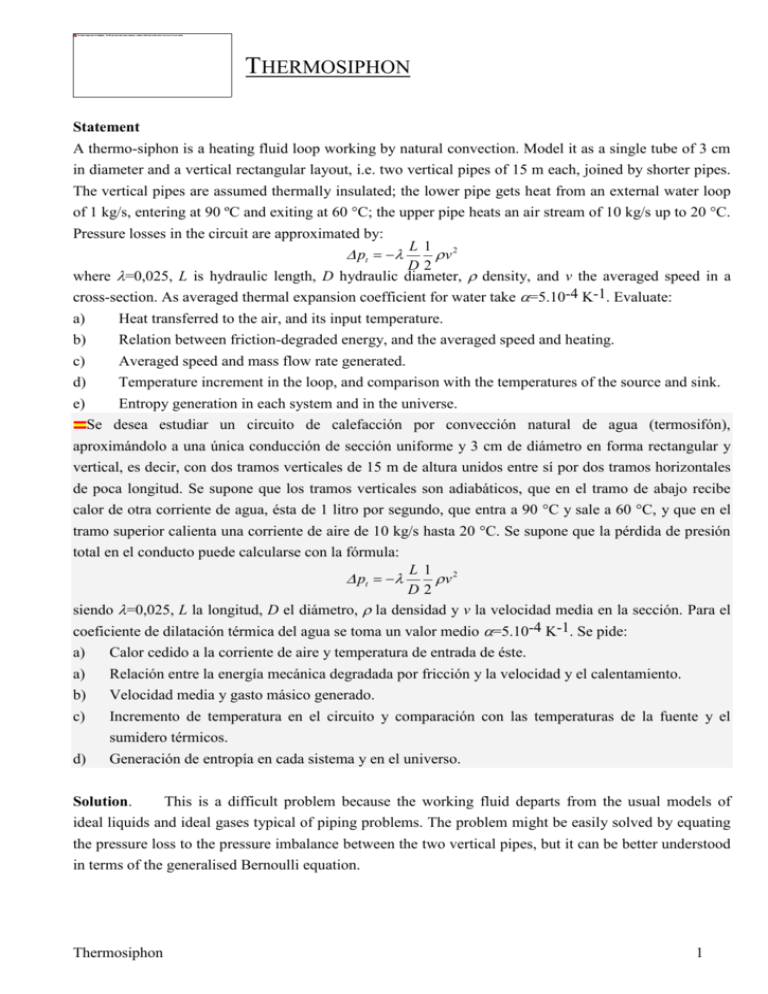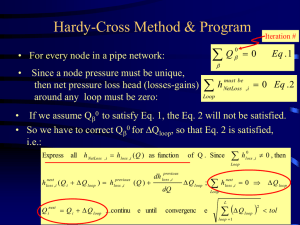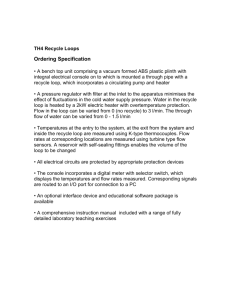Exercise7
advertisement

THERMOSIPHON Statement A thermo-siphon is a heating fluid loop working by natural convection. Model it as a single tube of 3 cm in diameter and a vertical rectangular layout, i.e. two vertical pipes of 15 m each, joined by shorter pipes. The vertical pipes are assumed thermally insulated; the lower pipe gets heat from an external water loop of 1 kg/s, entering at 90 ºC and exiting at 60 °C; the upper pipe heats an air stream of 10 kg/s up to 20 °C. Pressure losses in the circuit are approximated by: L1 2 pt v D2 where =0,025, L is hydraulic length, D hydraulic diameter, density, and v the averaged speed in a cross-section. As averaged thermal expansion coefficient for water take =5.10-4 K-1. Evaluate: a) b) c) d) e) Heat transferred to the air, and its input temperature. Relation between friction-degraded energy, and the averaged speed and heating. Averaged speed and mass flow rate generated. Temperature increment in the loop, and comparison with the temperatures of the source and sink. Entropy generation in each system and in the universe. Se desea estudiar un circuito de calefacción por convección natural de agua (termosifón), aproximándolo a una única conducción de sección uniforme y 3 cm de diámetro en forma rectangular y vertical, es decir, con dos tramos verticales de 15 m de altura unidos entre sí por dos tramos horizontales de poca longitud. Se supone que los tramos verticales son adiabáticos, que en el tramo de abajo recibe calor de otra corriente de agua, ésta de 1 litro por segundo, que entra a 90 °C y sale a 60 °C, y que en el tramo superior calienta una corriente de aire de 10 kg/s hasta 20 °C. Se supone que la pérdida de presión total en el conducto puede calcularse con la fórmula: L1 2 pt v D2 siendo =0,025, L la longitud, D el diámetro, la densidad y v la velocidad media en la sección. Para el coeficiente de dilatación térmica del agua se toma un valor medio =5.10-4 K-1. Se pide: a) Calor cedido a la corriente de aire y temperatura de entrada de éste. a) Relación entre la energía mecánica degradada por fricción y la velocidad y el calentamiento. b) Velocidad media y gasto másico generado. c) Incremento de temperatura en el circuito y comparación con las temperaturas de la fuente y el d) sumidero térmicos. Generación de entropía en cada sistema y en el universo. Solution. This is a difficult problem because the working fluid departs from the usual models of ideal liquids and ideal gases typical of piping problems. The problem might be easily solved by equating the pressure loss to the pressure imbalance between the two vertical pipes, but it can be better understood in terms of the generalised Bernoulli equation. Thermosiphon 1 Fig. 1. Sketch of the main fluid loop and the input and output heat sources. a) b) c) d) Heat transferred to the air, and its input temperature. All energy input from the hot-water stream at the bottom is transported by the closed water loop to the air stream above: Q Qw Qa mwcw T90 T60 mac pa T20 Ta1 , and substituting we get Q =125 kW and Ta1=7.5 ºC. Relation between friction-degraded energy, and the averaged speed and heating. dp em emdf to the whole loop, w=0, em=0, and emdf>0, one realises that the Applying w source of motion is the non-constancy of the density in the pressure term. We may model the loop as a hot left pipe (left because of the asymmetry in Fig. 1) of constant density, H, and a cold right pipe of constant, but different, density, C. Neglecting the short pipes: p p pt L1 2 0 gL emdf L , 0 gL emdf L with emdf L v , although it is better to C D2 multiply each of the partial Bernoulli equations by its density and add them up, getting: L1 2 0 0 gL( C ) 2 v , that with the linear expansion dilatable liquid model (4.30), D2 L1 2 v , that shows that the pressure head is the 0 1 T T0 yields: T gL 2 D2 difference in weight of the two columns of liquid. D2 cT The other relation is between the heat input and the heating achieved: Q mcT v 4 =125 kW. Averaged speed and mass flow rate generated. From the two equation above we get v=0.8 m/s and T=54 ºC. Temperature increment in the loop, and comparison with the temperatures of the source and sink. Is it possible to go up and down 54 ºC when the heating water exists at 60 ºC and the sink air at 20 ºC? Fig. 2 shows that it is possible indeed, but countercurrent heat exchanger must be used (the minimum thermal capacity is that of the loop: mc=2300 W/K against 4180 W/K for the hot source water and 10000 W/K for the cold sink air). Fig. 2. Combined temperature sketch for the two heat exchangers. Thermosiphon 2 e) Entropy generation in each system and in the universe. Sloop=0 because of the steady state; Shot water=mcln(T60/T90)=360 W/K; Scold air=mcln(T20/Tair in)=440 W/K; thus there is an entropy increase for the universe of some 80 W/K. Comments We have learned that chimney draft is p=gL. Back Thermosiphon 3






